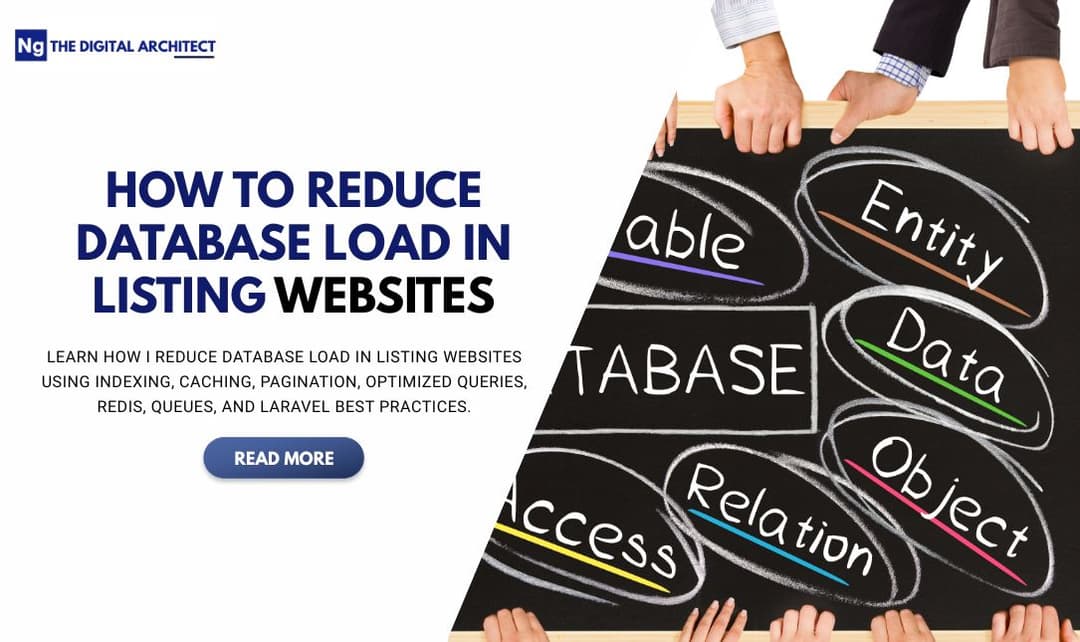Listing websites such as business directories, doctor appointment portals, real estate listings, service marketplaces, and e-commerce catalogs handle thousands of records. As the platform grows, the biggest challenge developers face is heavy database load. High database load slows down the website, increases server usage, reduces user experience, and negatively impacts SEO.
I am Nishant Gupta – The Digital Architect, and I’ve built large-scale listing websites like Helpcure.in (healthcare listings), HindSearch.com (business directory), and similar dynamic platforms. Through real-world experience, I’ve learned proven techniques to optimize queries, reduce database load, and improve speed—even when handling thousands of records.
In this blog, I’ll share my complete process for optimizing and reducing database load in listing websites, especially those built with Laravel.
Why Database Load Is High in Listing Websites
Listing websites rely heavily on the database because:
- They fetch large numbers of listings
- They have complex filters (city, category, price, features, etc.)
- Dynamic search queries run frequently
- Multiple users access data simultaneously
- Each page often requires multiple relational joins
If not optimized, even 5,000 records can slow the entire website.
How I Reduce Database Load in Listing Websites (My Proven Workflow)
Here are the real optimization techniques I implement in professional projects.
1. Use Efficient Database Indexing
Indexing is the backbone of database optimization.
I index frequently searched fields such as:
- City
- Category
- Slug
- Phone number
- User ID
- Status
With indexing, search and filter queries become 50x faster.
2. Replace N+1 Queries with Eager Loading
The N+1 problem is common in Laravel applications. Instead of writing queries inside loops, I use:
- with()
- load()
This reduces 200+ queries to just 2–3 highly optimized ones.
3. Use Pagination Instead of Fetching All Records
Never load hundreds of listings at once.
I use:
$listings = Listing::paginate(12);Pagination dramatically reduces database load and improves user experience.
4. Use Caching to Reduce Repeated Queries
Caching is one of the most effective ways to reduce DB load.
I use Redis or file cache for:
- Homepage listings
- Category pages
- Popular searches
- Filters
- Sidebar data
A cached page loads in milliseconds instead of seconds.
5. Preload Common Filters & Static Data
Filters like:
- Cities
- Categories
- Amenities
- Specialities
should not be fetched repeatedly from DB. I cache them or store them in config or JSON files.
6. Use Selective Fields Instead of Full Data Fetching
Instead of:
Listing::all();I use:
Listing::select('id', 'name', 'slug', 'city', 'rating')->paginate(12);This reduces data size by 80%.
7. Limit Heavy Joins and Move Complex Logic to Backend
Multiple joins slow down listing websites.
I optimize by:
- Breaking down queries
- Using relationships properly
- Caching joined data
- Storing pre-calculated values
For example: Instead of calculating doctor rating dynamically, I store an updated rating column.
8. Build a Separate Search Table for Fast Searching
For large projects, I create a “search table” optimized for filtering and searching.
This helps reduce DB load by 60–70%.
9. Use Database Query Caching on Heavy Pages
Pages like:
- Most popular listings
- Top-rated listings
- Latest listings
should use query caching:
Cache::remember('popular_listings', 3600, function(){
return Listing::orderBy('views','desc')->take(10)->get();
});10. Optimize Images With CDN or Lazy Loading
Image-heavy pages slow down listing websites. I reduce load using:
- Lazy loading
- WebP format
- CDN-based image serving
This reduces server load and improves Core Web Vitals.
11. Use Full-Text Search Instead of “LIKE” Queries
LIKE searches are slow:
where('name','LIKE','%john%')Instead, I use:
- MySQL full-text search
- Scout + MeiliSearch (for large DBs)
- Elasticsearch (enterprise level)
Making search operations extremely fast.
12. Offload Analytics & Tracking to Separate Tables
Tracking:
- Views
- Clicks
- Leads
- Ratings
should not overload main listing tables.
I store analytics in separate tables and update aggregates periodically.
13. Use Queue System for Heavy Operations
Never run heavy tasks during a user request.
I use queues for:
- Email sending
- Analytics updates
- Bulk imports
- Image processing
This keeps the database free and responsive.
14. Database Query Optimization and EXPLAIN Analysis
I regularly run:
EXPLAIN SELECT ...This helps identify:
- Slow queries
- Missing indexes
- Inefficient joins
- Unused conditions
This step alone improves performance significantly.
15. Using Redis for Session, Cache, and Queues
Redis is extremely fast and reduces load from MySQL.
I use Redis for:
- Caching
- Session handling
- Queue management
- Rate limiting
This removes unnecessary load from MySQL and boosts performance.
Real Examples From My Projects
Helpcure.in (Doctor Listing Website)
This project required complex filters (city, speciality, doctor type). I optimized load using:
- Indexing
- Caching
- Queue system
- Pre-calculated ratings
The result? The listing pages load in under 400ms.
HindSearch.com (Business Directory)
With hundreds of listings, I optimized using:
- Search table
- Redis caching
- Optimized pagination
This reduced DB queries by 65%.
AdmissionAdvisior.in & RIVH.org
Both required fast listing/loading pages, achieved using:
- Lazy loading
- Selective data fetching
The user experience improved significantly.
Why Optimizing Database Load Is Important
- Faster page loading
- Better SEO ranking
- Lower hosting cost
- Better performance during peak traffic
- Improved user experience
A well-optimized listing website can handle thousands of users smoothly.
Need a High-Performance Listing Website?
If you want a listing platform that is fast, scalable, and optimized, I can help you build a powerful solution.
Contact me today for high-performance website development.






